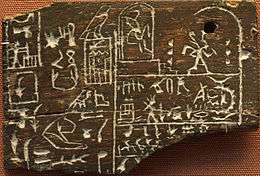Bee (hieroglyph)
| ||
| Bee bit/bity in hieroglyphs |
|---|

(clay)
The ancient Egyptian Bee (hieroglyph), Gardiner sign listed no. L2, is the representation of a honeybee. The bee figures prominently throughout Ancient Egyptian history, and started in the early Protodynastic Period, for example with Pharaoh Den. His timeperiod famously produced 20 tomb-labels (tags) that recorded events, and told short stories, with the first use of hieroglyphs, that by 2900 BC time had included biliterals, some triliterals, and the Egyptian hieroglyphic uniliterals.
The form of the bee on Den's labels, and others in the timeperiond (Semerkhet), show similar form, a flying bee, at an angle. The later forms are more "horizontal, wings outspread".
|
|
|
|
|
In the Egyptian language, the bee (hieroglyph) is used as an idiogram for the "bee"; it has the phonetic value in the language usage for bit.[1]
Early usage, King Den & Palermo Stone

(one of 20 labels from the timeperiod)
(non-expert rendering of hieroglyphs: Bee is flying at an angle at upper left, with a "seal on a cord",
|
|
_1.jpg)
The Bee (hieroglyph) is used prominently in the 24th century BC Palermo Stone. The year-events are listed in rows of "year-registers", and one of the common events is the "appearance of the King of the North" (or "King of the South", or both).
See also
| Wikimedia Commons has media related to Bee (hieroglyph). |
References
- ↑ Betrò, 1995. Hieroglyphics: The Writings of Ancient Egypt, p. 117.
- Betrò, 1995. Hieroglyphics: The Writings of Ancient Egypt, Betrò, Maria Carmela, c. 1995, 1996-(English), Abbeville Press Publishers, New York, London, Paris (hardcover, ISBN 0-7892-0232-8)
- Budge, (1920), 1978. An Egyptian Hieroglyphic Dictionary, E.A.Wallace Budge, (Dover Publications), c 1978, (c 1920), Dover edition, 1978. (In two volumes, 1314 pp. and cliv-(154) pp.) (softcover, ISBN 0-486-23615-3)